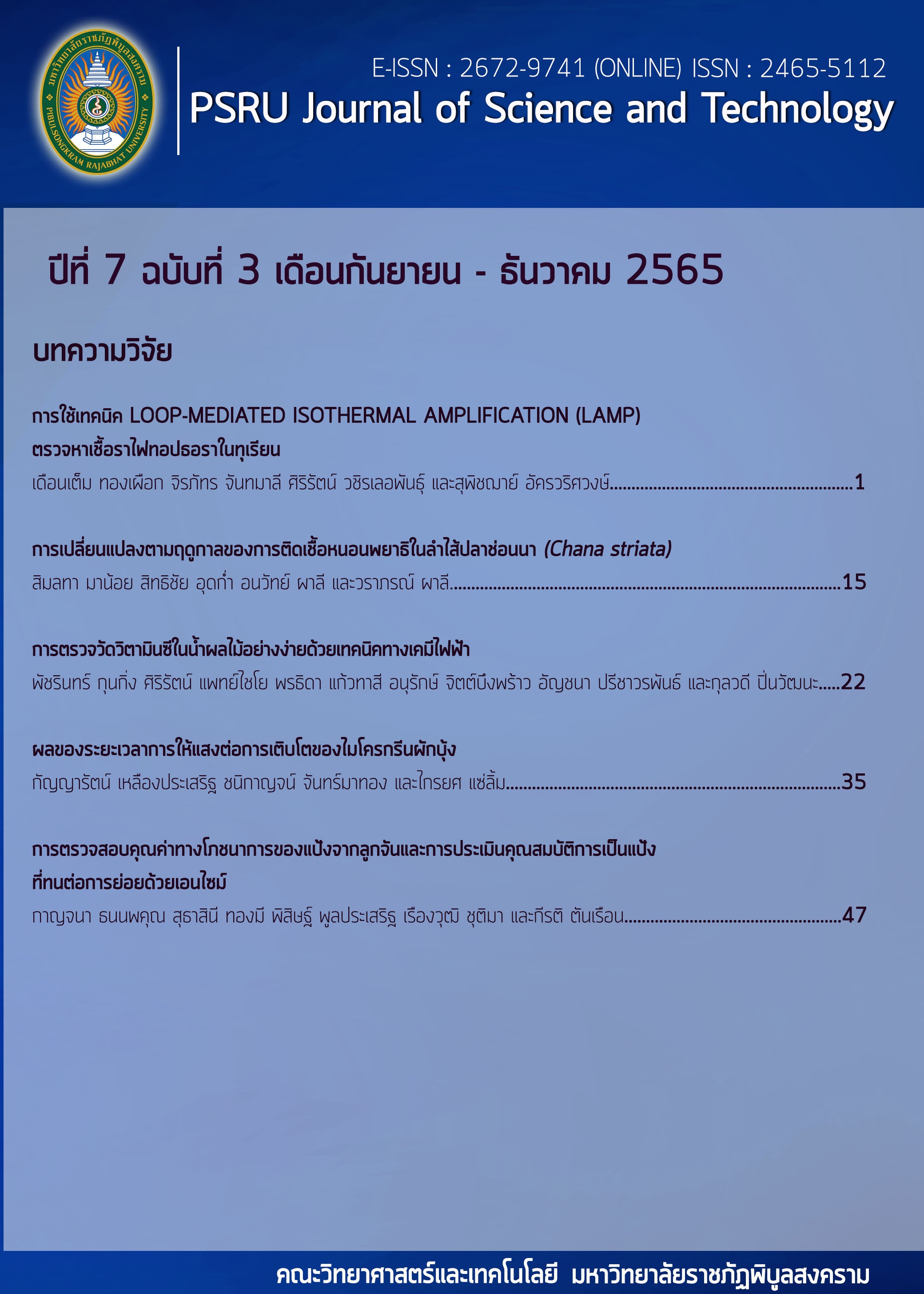SIMPLE ANALYSIS OF VITAMIN C IN FRUIT JUICE SAMPLES BY ELECTROCHEMISTRY
Keywords:
Vitamin C, Fruit juice, Amperometry, glassy carbon electrodeAbstract
In This research, we determined vitamin C in fruit juice using amperometry at glassy carbon working electrode. The mechanism of electrochemical oxidation of vitamin C was investigated by cyclic voltammetry in various pH 4 to 8 of phosphate buffers. The result showed that the optimum pH of an electrolyte solution is phosphate buffer pH 6, that appears oxidation peak at 0.44 V with scan rate 0.1 V/s using cyclic voltammetric detection. Amperometric technique was used for vitamin C quantitative by stirring throughout the experiment with optimum potential of 0.5 V. It displayed a wide dynamic calibration range 10 to 266 µM with high sensitivity of 4.78 µA/mM. The limit of detection and limit of quantification are 1.39 µM and 4.62 µM, respectively. Furthermore, the proposed method was successfully applied to analyze ascorbic acid in fruit juice samples of fresh lemon juice and 100% orange juice box. They exhibited a reasonable relative of the percent recovery in the range of 80–97.
References
ฉัตรชัย ยมศรีเคน. (2562) การวินิจฉัยและการรักษาภาวะอ่อนแรงผู้ป่วยโรคขาดวิตามินซี (โรคลักปิดลักเปิด): รายงานผู้ป่วย 2 ราย ในโรงพยาบาลมหาสารคาม. วารสารโรงพยาบาลมหาสารคาม, 16(2), 62-71.
El-Malla, S.F., Elattar, R.H., Kamal, A.H., & Mansour, F.R. (2022). A highly sensitive switch-on spectrofluorometric method for determination of ascorbic acid using a selective eco-friendly approach. Spectrochimica Acta Part A: Molecular and Biomolecular Spectroscopy, 270, 120802.
Fontannaz, P., Kilinç, T., & Heudi, O. (2006). HPLC-UV determination of total vitamin C in a wide range of fortified food products. Food Chemistry, 94(4), 626-631.
Garnero, C., & Longhi, M. (2010). Development of HPLC and UV spectrophotometric methods for
the determination of ascorbic acid using hydroxypropyl-β-cyclodextrin and triethanolamine as photostabilizing agents. Analytica Chimica Acta, 659(1), 159-166.
Indrayanto, G. (2018). Validation of chromatographic methods of analysis: application for drugs that derived from herbs. Profiles Drug Subst Excip Relat Methodol, 43, 359-392.
Klimczak, I., & Gliszczyńska-Świgło, A. (2015). Comparison of UPLC and HPLC methods for determination of vitamin C. Food Chemistry, 175, 100-105.
Konieczka, P. (2007). The role of and the place of method validation in the quality assurance and quality control (QA/QC) system. Critical Reviews in Analytical Chemistry - CRIT REV ANAL CHEM, 37, 173-190.
Li, H., Zhou, Y., & Du, J. (2022). Ascorbic acid as an alternative coreactant for luminol reaction and sensitive chemiluminescence determination of ascorbic acid in soft drinks. Journal of Photochemistry and Photobiology A: Chemistry, 429, 113945.
Pisoschi, A.M., Danet, A.F., & Kalinowski, S. (2008). Ascorbic acid determination in commercial fruit juice samples by cyclic voltammetry. Journal of Automated Methods and Management in Chemistry, 2008, 937651.
Razmi, H., & Bahadori, Y. (2021). Chicken feet yellow membrane/over-oxidized carbon paste electrodes:
A novel electrochemical platform for determination of vitamin C. Microchemical Journal, 168, 106442.
Saleh Mohammadnia, M., Marzi Khosrowshahi, E., Naghian, E., Homayoun Keihan, A., Sohouli, E., Plonska-Brzezinska, M. E., Ali-Sobhani, N., Rahimi, M., & Ahmadi, F. (2020). Application of carbon nanoonion-NiMoO4-MnWO4 nanocomposite for modification of glassy carbon electrode: Electrochemical determination of ascorbic acid. Microchemical Journal, 159, 105470.
Saranchina, N.V., Damzina, A.A., Gavrilenko, N.A., Volgina, T.N., Ermolaev, Y.E., Polonskaya, M.S., & Gavrilenko, M.A. (2022). Rapid colorimetric determination of ascorbic acid by solid phase extraction of iodine into a polymethacrylate matrix. Mendeleev Communications, 32(1), 136-138.
Spínola, V., Mendes, B., Câmara, J.S., & Castilho, P.C. (2013). Effect of time and temperature on vitamin C stability in horticultural extracts. UHPLC-PDA vs iodometric titration as analytical methods. LWT - Food Science and Technology, 50(2), 489-495.
Suntornsuk, L., Gritsanapun, W., Nilkamhank, S., & Paochom, A. (2002). Quantitation of vitamin C content in herbal juice using direct titration. Journal of Pharmaceutical and Biomedical Analysis, 28(5), 849-855.
Thakthuang, S., Sopaporn, P., Meksun, S., Chitbuengphrao, A., Pinwattana, K., & Preechaworapun, A. (2021). Determination of ascorbic acid in juices using the chronoamperometry. PSRU Journal of Science and Technology, 6(1), 1-12.
Uğur, H., Çatak, J., Mızrak, Ö.F., Çebi, N., & Yaman, M. (2020). Determination and evaluation of in vitro bioaccessibility of added vitamin C in commercially available fruit-, vegetable-, and cereal-based baby foods. Food Chemistry, 330, 127166.
Downloads
Published
How to Cite
Issue
Section
License
Copyright (c) 2022 PSRU Journal of Science and Technology

This work is licensed under a Creative Commons Attribution-NonCommercial-NoDerivatives 4.0 International License.
กองบรรณาธิการขอสงวนสิทธิ์ในการปรับปรุงแก้ไขตัวอักษรและคำสะกดต่างๆ ที่ไม่ถูกต้อง และต้นฉบับที่ได้รับการตีพิมพ์ในวารสาร PSRU Journal of Science and Technology ถือเป็นกรรมสิทธิ์ของคณะวิทยาศาสตร์และเทคโนโลยี มหาวิทยาลัยราชภัฏพิบูลสงคราม และ
ผลการพิจารณาคัดเลือกบทความตีพิมพ์ในวารสารให้ถือมติของกองบรรณาธิการเป็นที่สิ้นสุด







